Ports and Shipping
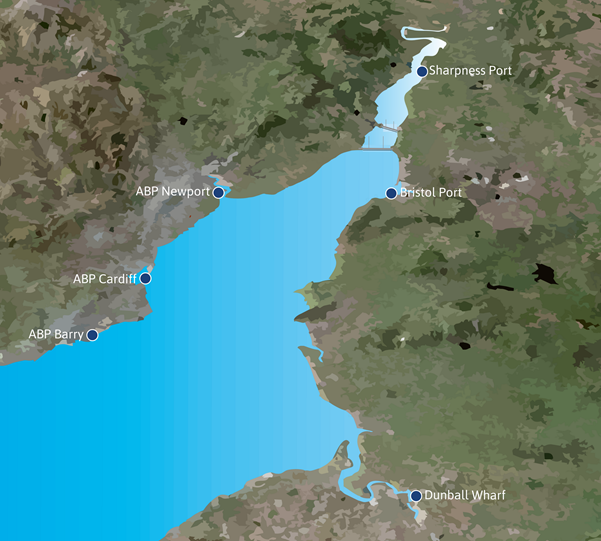
Almost all the major towns and cities around the Severn Estuary developed largely as a result of sea trade which brought prosperity and employment to the region. In the 19th and 20th centuries many established in-river and coastal wharves were replaced with impounded docks more suited to deal with the expansion of trade, larger vessels and the high tidal range. At some, such as Lydney, Gloucester, Bristol City, Portishead and Penarth Docks, trade has long ceased and they now mainly operate to service the recreation sector as marinas. Others, however, still provide a vital channel for sea trade. These ports and the services they support continue to have an important role in the local, regional and national economy as they are responsible for handling a substantial proportion of UK trade. The major commercial ports of the Severn Estuary are Bristol (Royal Portbury and Avonmouth Docks), Cardiff, Newport with smaller operations at Sharpness, Barry and Bridgwater (Dunball Wharf).
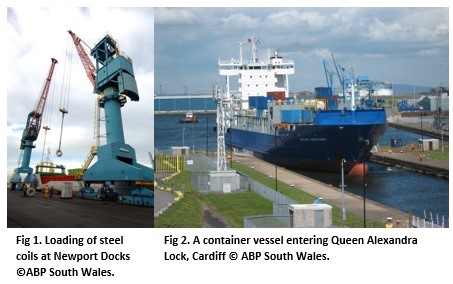
Port Activity
A key factor in the development of the Severn Estuary ports was the need to cater for the vast export trade of the 19th and 20th centuries. Whilst Bristol handled large volumes of imported goods, trade at other ports, particularly those of South Wales was dominated by the export trade. The changes of fortunes in Britain’s manufacturing and heavy industries, for example, the coal exports of South Wales, were largely responsible for the significant decline in export trade and overall port traffic in the latter half of the 20th century. Trade dynamics changed from exports to imports and now, as with most other British ports, by far the greater proportion of cargo tonnage handled at all the Severn Estuary ports, is imported trade (Table 1).
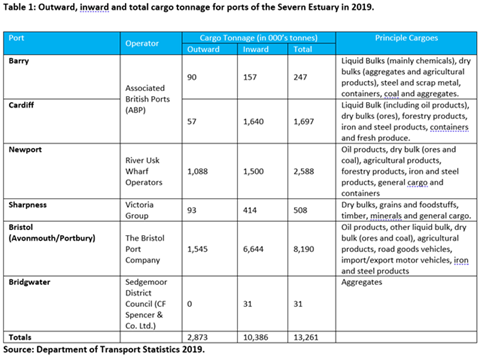
The 2008 recession resulted in the largest year on year decline seen in the last 30 years, when port freight fell by 11% between 2008 and 2009. UK total tonnage levels stabilised in recent years, however, total freight tonnage traffic for the Severn Estuary ports decreased in 2015 by 15.8% to just over 14 million tonnes.
In 2019, the Port of Bristol (Avonmouth and Royal Portbury Docks) handled 8,190,000 tonnes of cargo, 62% of all estuary cargo.
In 2019 total tonnage handled in Welsh ports increased by 8% compared to the previous year, despite a steady decline over the past three years.
2019 Quick Facts
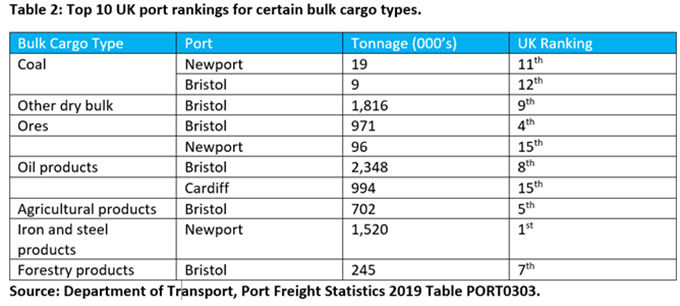
Port Investment
To remain competitive, ports need to constantly adapt to changing markets and developments in both transportation practices and cargo handling technology and many of the ports have invested heavily in new dockside facilities in the last decade.
In 2014 and 2015, ABP made significant investment at Newport Docks that included new mobile cranes (Fig. 4), renewable energy projects, a new rail bridge and quay strengthening work. Investment to meet the needs of port customers continued in 2016 with the £2.8 million refurbishment of 3 of the quayside cranes and the commencement of a £2.3 million project to develop new warehousing space (3,500m2) to accommodate increasing agriculture related cargo volume at the port.
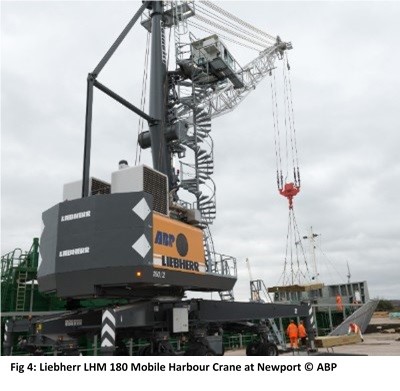
Tidal Constraints
The extreme tidal range within the Severn Estuary (over 14m at Avonmouth, and 10m at Barry on the largest Spring tides) presents a constant challenge to both navigation and port operations. Access to the ports is very dependent on the ship’s draught (the distance between the waterline and the bottom of the hull) and the size of tide i.e., the depth of water. Access to some ports is often only possible during the incoming high tides, and though the extremely high spring tide levels provide suitable conditions for very large ships with deep draughts, ships have to time their arrival in the Estuary to coincide with suitable tide conditions.

A further potential constraint to each port’s operations is the maximum size of vessel which can be received in its locks. Apart from Royal Portbury Dock, which was completed in 1977 (with the largest entrance lock in the UK), all the impounded docks and their locks were built over one hundred years ago, when vessel sizes were far smaller. This restriction is likely to have a significant bearing in the type of business a port can attract and how it may adapt to future changes in maritime trade (Table 3).
The use of river wharfs such as at Newport and Dunball (Bridgwater) continues, and though the use of locks is not an issue, there remains the need for careful consideration of tide conditions.
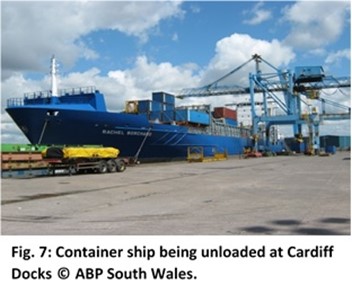
Shipping
Cargo vessels come in a huge variety of sizes and designs, with many ships now built to carry a specific cargo type to ensure their travel is as efficient as possible. The wide variety of facilities offered at the Severn Estuary ports means that many vessel types can be seen on the Estuary; dry-bulk carriers (Fig. 6) transporting grain, coal, ore and other similar products in loose form, tankers carrying chemicals and petroleum products, container ships (Fig. 7), car carriers (Fig. 8), sand dredgers and both general cargo and multi-purpose vessels.
During 2019, 2,943 vessels called at the main Severn Estuary ports, a decrease of 165 from 2018. Bristol continues to be the busiest port, having received 1,688 ships (57%), Newport received 615 (21%) and Cardiff 380 (13%).
The Bristol Bulk Terminal can receive very large ships and can handle ships up to 130,000 deadweight (Fig. 6) (see ‘deadweight’ definition below). However, the majority of ships calling at the Estuary ports are far smaller with 66% of the 2019 traffic being less than 20,000 tonnes and 24% under 5,000 tonnes (Table 4).
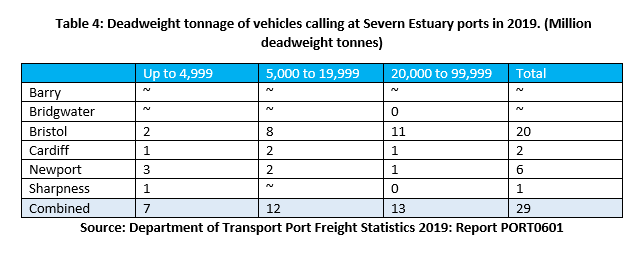
Deadweight tonnage (abbreviated to DWT) is a measure of how much weight a ship is carrying or can safely carry; it does not include the weight of the ship.
In terms of shipping classification based on cargo type, 55.2% of the ships in 2019 carried ‘dry cargo’, 10.6% were tankers carrying liquid cargo, and 7.3% were dedicated container ships. From Table 5 below it can be seen that 674 (25.7%) vessel visits have been classified by the Department of Transport as ‘Other’; a large portion of this figure is attributable to aggregate dredgers and tug traffic, and possibly also dredgers undertaking maintenance activities.
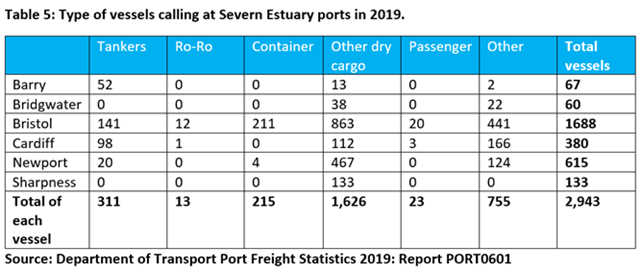
Ro-Ro or Roll on – Roll off is the term given to ships designed to carry wheeled cargo such as vehicles and trailers that are driven or towed on and off the ship. Ro-Ro vessels have built-in ramps that allow the cargo to be efficiently rolled on and off the vessel within port.

Maintenance dredging
Many areas of the Severn Estuary are subject to large sediment depositions that require dredging in order to maintain safe navigable depths. A number of ports have to regularly dredge their approach channels, dock entrances, locks and dock basins. Every year, several hundred thousand cubic metres of material is removed from each of Cardiff, Newport and Royal Portbury/Avonmouth Docks. The disposal of maintenance dredged material at sea is a highly regulated activity with volumes capped by licences and use of dedicated disposal sites. The main navigation channel in the Severn Estuary does not require dredging as it is deep and naturally scoured by the tidal currents.
For more information, visit
- Port Freight Statistics Department for Transport
- Shipping Movements Automatic Identification System
- Ports
- Associated British Ports (South Wales) Barry, Cardiff & Newport
- The Bristol Port Company Avonmouth and Portbury
- Newport Harbour Commissioners Newport,
- Bird Port
- Sharpness (inc. Gloucester)
- Bridgwater Sedgemoor District Council
 Severn Estuary Partnership
Severn Estuary Partnership